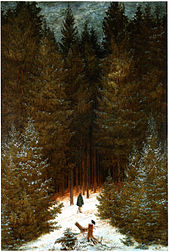solitude of the forest

With Waldeinsamkeit , one aspect of the motif of loneliness , a religious is ascetic ideal escaped, part of the Asian monasticism and also to the medieval monasticism of the West was widespread. The term experienced its own accentuation as a literary motif in Romanticism .
religion
In the ascetic tradition of Hinduism , the solitude of the forest voluntarily sought out by the Vānaprastha ("forest monk") plays a decisive role, just as in Buddhism up to its present day in Thailand as Tudong in the Buddhist forest tradition or in the West.
In European Christian monasticism, until the late Middle Ages, hermits and hermits sought refuge in seclusion in the forest, on the one hand from the hustle and bustle in the city (see ways of life in monasticism ) and, on the other hand, from secular tendencies in the monastery (like the Vallombrosans ), where they were caused by the people often received high esteem.
Pre-romantic literature

In Wolfram von Eschenbach's verse epic Parzival , the figure of Trevrizent embodies the ideal of the ascetic living in the loneliness of the forest. The image of the Einsiedel in the forest was taken up in Grimmelshausen's Der adventurous Simplicissimus in 1668 and became a literary subject in the Baroque poetry .
Romantic literature
In German romanticism, the loneliness of the forest becomes a key concept. The forest is linked as an idyllic and eternal ideal with the loneliness of the introverted romantic poet type. In the Romantic Movement, the term first appeared in 1796 in the fairy tale Der blond Eckbert by Ludwig Tieck , who used the term as a symbol for the ideal world in the inner and outer experiences of the protagonist Bertha. In the form of the poem , the expression of a bird is introduced, whereby the content of the poem changes with Bertha's involvement in misdeeds.
- Solitude of the forest,
- That delights me
- As tomorrow as today
- In eternal time
- O how happy I am
- Solitude of the forest.
- solitude of the forest
- How far are you!
- O you regretted
- Once upon a time.
- Oh, only joy
- Solitude of the forest!
- solitude of the forest
- I am happy again
- No harm happens to me
- There is no envy here
- I am happy again
- Solitude of the forest.
Joseph von Eichendorff uses the term to transfigure the forest as a timeless idyll that contrasts with ephemeral humanity. The motif occupies a decisive position in the entire literary work of this poet. In addition to a poem entitled Waldeinsamkeit in the cycle Der Umkehrende , the motif appears in many famous poems such as Farewell to the Forest , In the Foreign or Come, Solace the World . It is no less important in his prose works , such as the story Das Schloß Dürande .
There are also poems by Heinrich Heine and Adolf von Tschabuschnig with this title. A late work by Joseph Viktor von Scheffel from 1884 is the twelve-part cycle of poems Waldeinsamkeit . When Emanuel Geibel the term in the poem In the Forest used.
The motif occurs without being named in numerous works of the Romantic period, since the forest and the lonely poet can be seen as key motifs of the epoch, as in the novel Heinrich von Ofterdingen by Novalis or in the poems of August von Platen , Ludwig Uhland or Nikolaus Lenaus .
The term found its way into American literature as untranslated Germanism, such as in Ralph Waldo Emerson's (1803–1882) poem Waldeinsamkeit (1858).
Painting and music
In painting , the motif of loneliness in the forest is particularly evident in Caspar David Friedrich , Carl Gustav Carus , Ernst Ferdinand Oehme , Ludwig Richter and Moritz von Schwind . Ludwig Richter's painting Genoveva in der Waldeinsamkeit is based on the legend of the Genoveva von Brabant , published by Gustav Schwab , and shows the forest as a landscape of longing and retreat with a religious touch typical of romanticism. The painter Hans Thoma later depicted the same motif . Julius Mařák 's depictions of the forest provided the basis for Scheffel's cycle of poems, Waldeinsamkeit .
In the music , the motif plays a role in Richard Wagner's operas Siegfried and Parsifal , as well as in the album "Waldeinsamkeit" by the Finnish black metal band Kalmankantaja.
Individual evidence
- ↑ The speeches of Gotamo Buddha. Vol. 1, Zurich / Vienna 41956, pp. 122–126
- ↑ Buddha and his disciples: Kassapa
- ↑ Birgit Stratmann, "Renunciation makes you rich" - a portrait of Wolfgang Krohn
- ↑ Fairy v. Lilienfeld: Monasticism II 3.3.2.1. Secularization of monasticism, in: Gerhard Müller (ed.), Theologische Realenzyklopädie, Volume 23 Berlin, New York, 1994, p. 170
- ↑ Jakob Koeman, The Grimmelshausen Reception in the Fictional Literature of German Romanticism B. The motif complex forest loneliness hermit night nightingale p. 285
- ↑ Hans Leibundgut: The forest in the cultural landscape. Significance, function and effects of the forest on the human environment. Bern, Stuttgart 1985. p. 114
- ↑ Ludwig Richter. The painter . Staatliche Kunstsammlungen Dresden, 2004. Page 216.
literature
- Tieck, Ludwig: Puss in Boots - fairy tales from "Phantasus" . Fischer Verlag, Frankfurt am Main 2008.
- Eichendorff, Joseph von: Poems . Philipp Reclam jun. GmbH & Co., Stuttgart 1997.
- Ludwig Richter. The painter . State Art Collections Dresden, 2004.
- Wolf, Norbert: Caspar David Friedrich . Taschen GmbH, Cologne 2007.
- Hammes, Michael Paul: "Forest loneliness". A motif and style investigation on German early romanticism, in particular on Ludwig Tieck, Limburg 1933